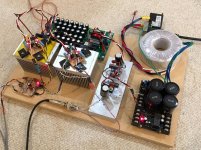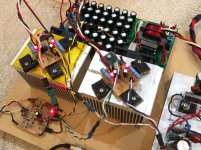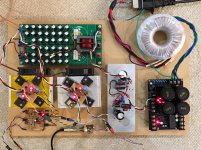My system is finally completed with proper power supply: 20VAC 100VA Antek toroidal providing +/-28.4V rails feeding a 20mF per rail COTS PSU with turn on delay relay, this then feed a Juma MOSFET cap multiplier which knocks it down to 24.5v rails and zero ripple, this then feeds an RLC filter cap bank with 20 x 1000uF caps per rail for low ESR. The Juma BF862 single ended preamp is fed upstream of the 0.47R de-coupling resistor following L and before the cap bank to help isolate the main amp transients from the preamp supply at +24v. This setup provides a 2.5mOhm ESR (50mOhm/20) 20,000uF supply rail which is shared between both channels. I know, I did not do monoblock PSU's but I figured that since I will be using a crosssfeed circuit, cross-talk isolation isn't top on my list. Anyhow, PSU ripple measures 0.000V (scope shows small 3mV spikes at MHz range from somewhere). Output of amp measures 0.0mV on DMM with input turned off (not shorted - DAC still connected).
This amp was moved from another thread.
Main amp is from here:
http://www.diyaudio.com/forums/head...llower-headphone-amplifier-3.html#post1130743
Preamp is from here:
http://www.diyaudio.com/forums/pass-labs/146310-bf862-preamp.html
Cap multiplier is from here:
http://www.diyaudio.com/forums/solid-state/297921-jumas-easy-peasy-capacitance-multiplier.html
Schematic as built combining preamp with follower power amp:
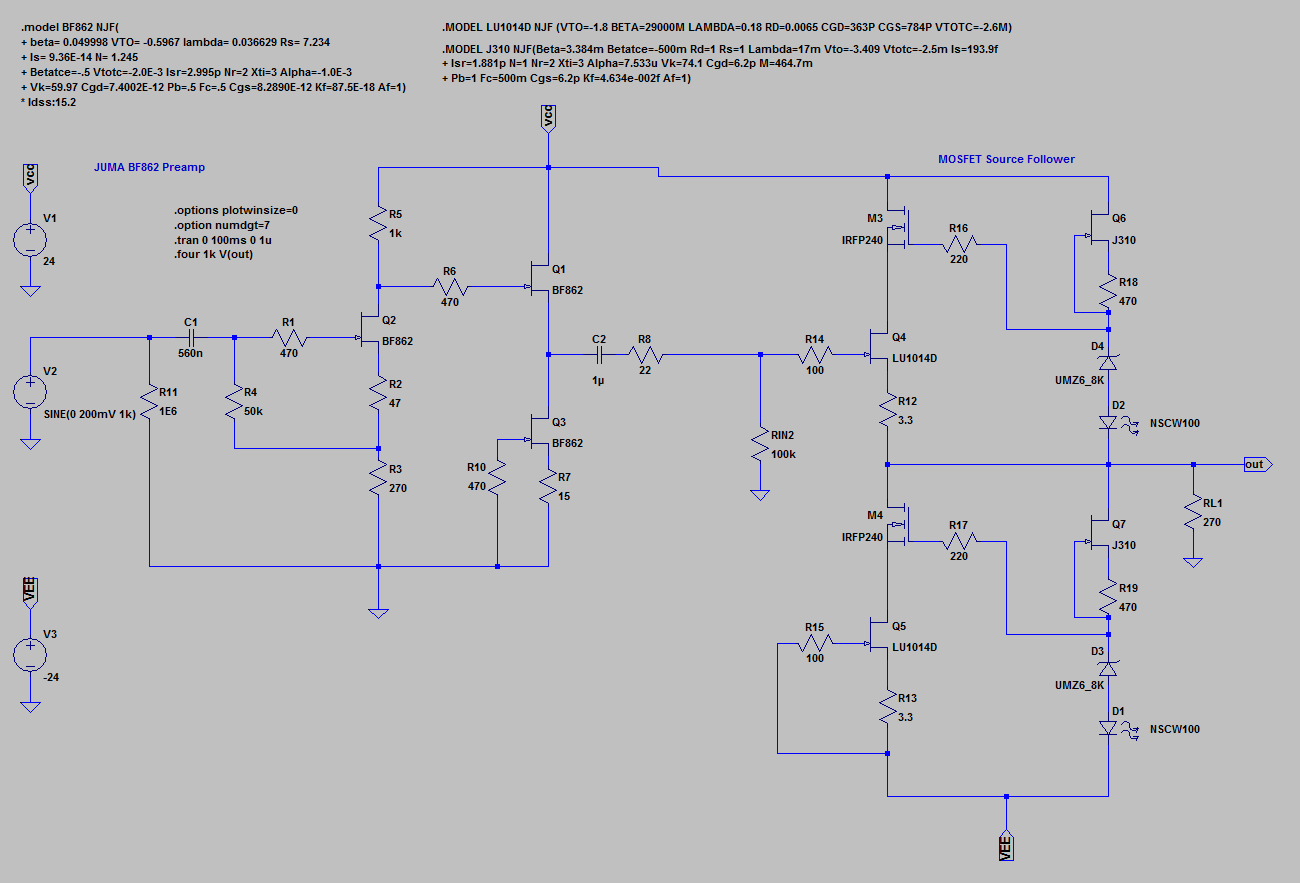
Predicted FFT:
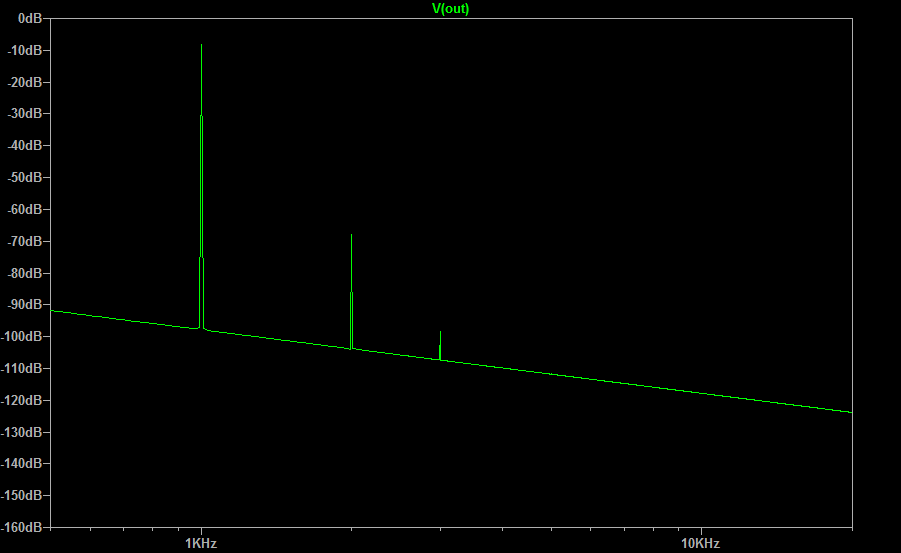
Same sonic signature for 60ohm load as well.
System laid out on wood board:
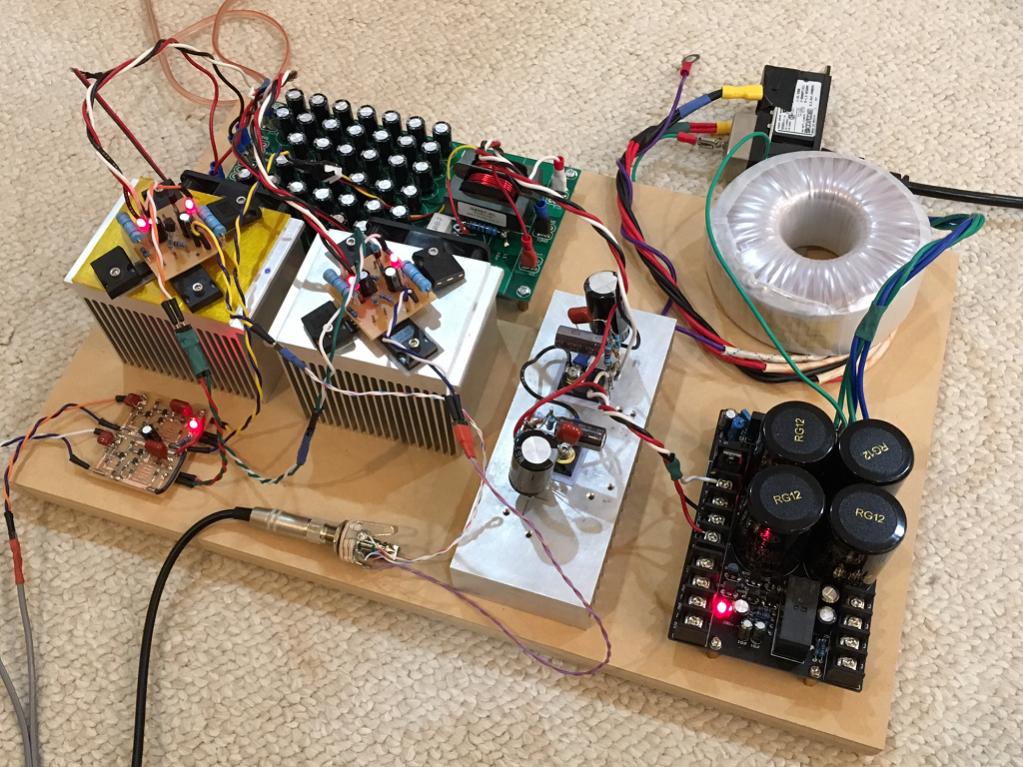
Closeup of preamp, amps, cap bank:
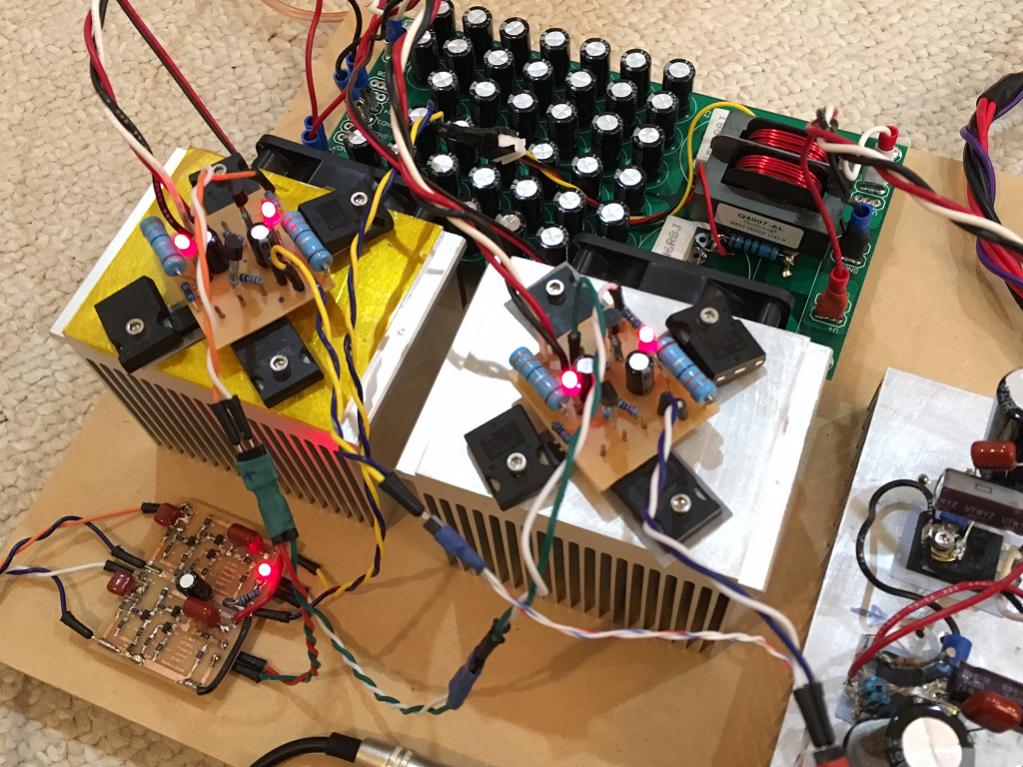
Top view:
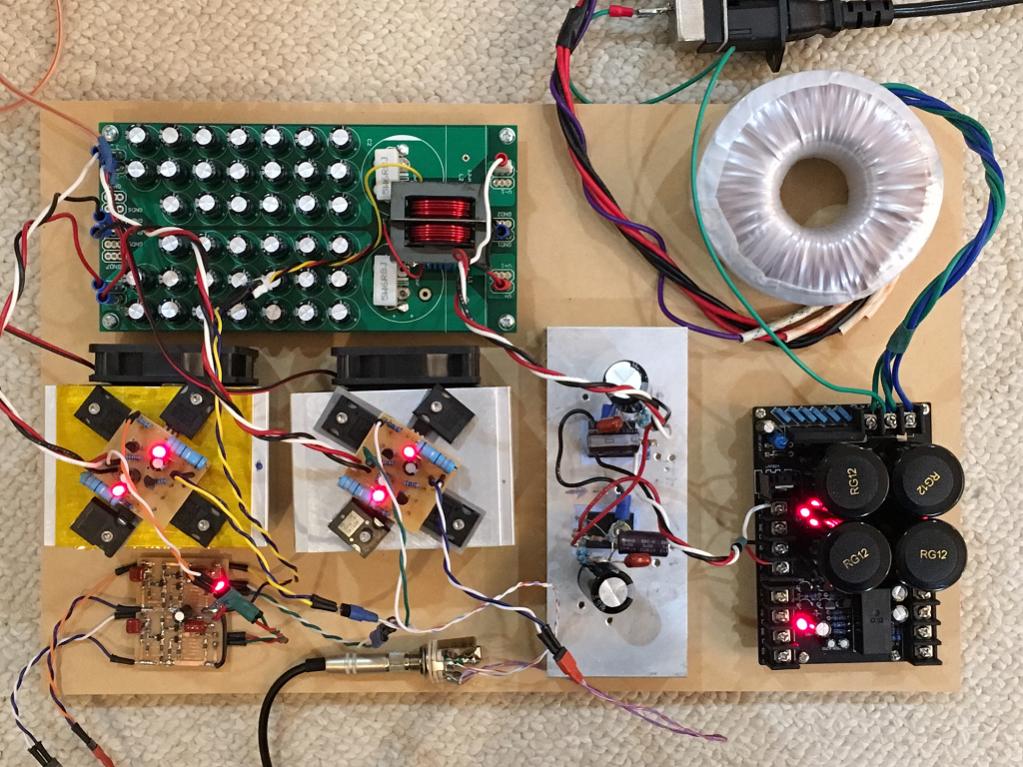
Anyhow, it's working very nicely. Absolutely dead silent when nonsignal playing. Bass like I have never heard before - that cap bank makes a difference. Head shaking bass. Everything else is great sounding as well - clear smooth midrange, lush vocals, superb highs with clarity and no audible distortion. Piano is a good test track to listen for distortion and piano sounds great. Anyhow, a wonderful sounding head amp.
Source for LU1014D JFETs:
http://www.deepsurplus.com/Electronic-Components/LU1014D-JFET
Edit: Dec 31, 2016 - new 2 FET design that almost keeps up with above much more complicated design:
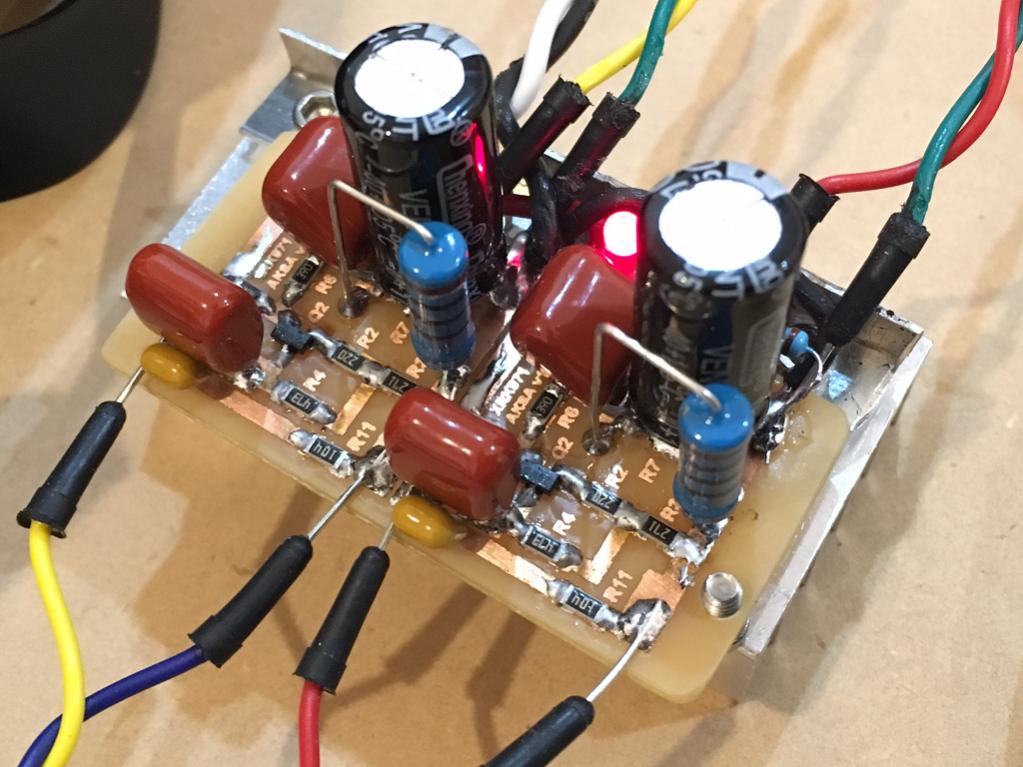
Schematic and HD analysis:
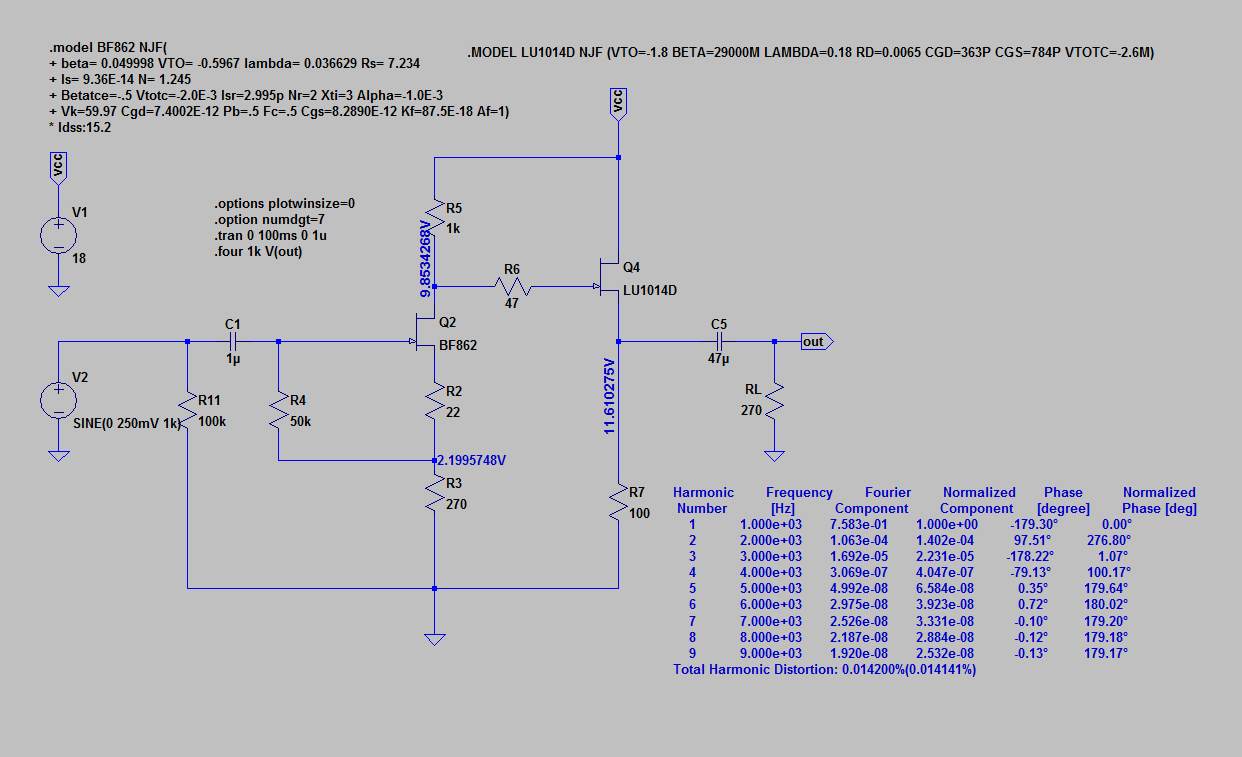
Predicted FFT:
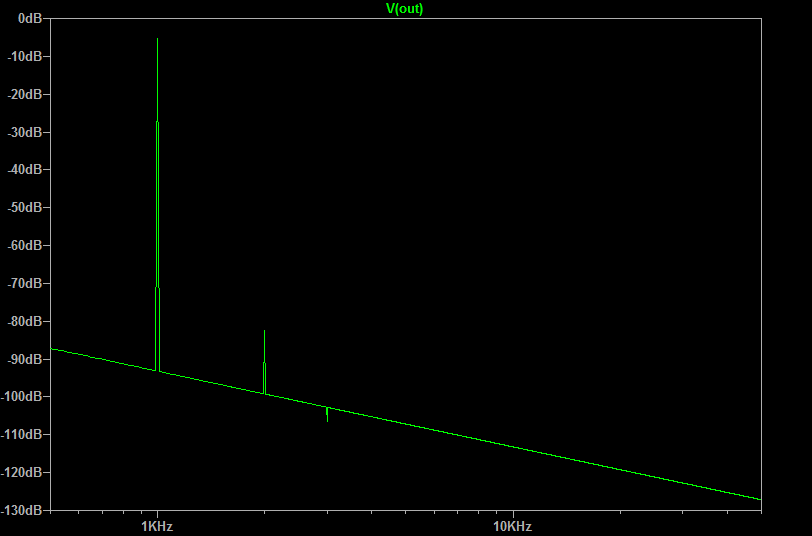
For size comparison, notice size of headphones relative to amp:
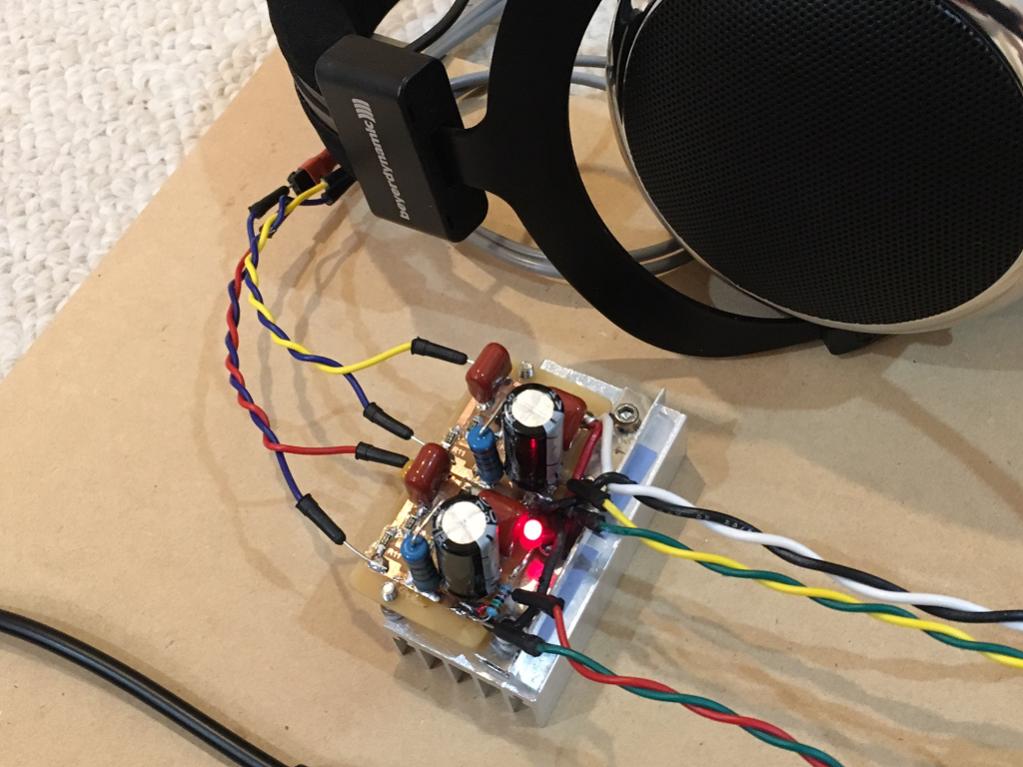
This amp was moved from another thread.
Main amp is from here:
http://www.diyaudio.com/forums/head...llower-headphone-amplifier-3.html#post1130743
Preamp is from here:
http://www.diyaudio.com/forums/pass-labs/146310-bf862-preamp.html
Cap multiplier is from here:
http://www.diyaudio.com/forums/solid-state/297921-jumas-easy-peasy-capacitance-multiplier.html
Schematic as built combining preamp with follower power amp:

Predicted FFT:

Same sonic signature for 60ohm load as well.
System laid out on wood board:

Closeup of preamp, amps, cap bank:

Top view:

Anyhow, it's working very nicely. Absolutely dead silent when nonsignal playing. Bass like I have never heard before - that cap bank makes a difference. Head shaking bass. Everything else is great sounding as well - clear smooth midrange, lush vocals, superb highs with clarity and no audible distortion. Piano is a good test track to listen for distortion and piano sounds great. Anyhow, a wonderful sounding head amp.
Source for LU1014D JFETs:
http://www.deepsurplus.com/Electronic-Components/LU1014D-JFET
Edit: Dec 31, 2016 - new 2 FET design that almost keeps up with above much more complicated design:

Schematic and HD analysis:

Predicted FFT:

For size comparison, notice size of headphones relative to amp:

Attachments
Last edited:
great work X
Thanks! It's so busy with holidays and family I haven't had much of a chance to chance to listen to it yet.
Jameshill says adding a resistive load in parallel (shunt to ground) helps improve sound. I may try adding 270R 3w metal film. That actually helped on my last amp.
Just listened to Pink Floyd's Wish You Were Here. Very nice indeed. 🙂
The great thing is that just about everything sounds great. Deep House mixes on YouTube sound really good - amazing bass.
The great thing is that just about everything sounds great. Deep House mixes on YouTube sound really good - amazing bass.
Amazing but adding that 270R (5w wirewound actually) in parallel really made it come alive even more. The mids and bass seemed to fill out even more and the soundstage opened up. What an interesting thing.
I like ,you have ,WiFi power transistor or electric washer ? Nice build ,anyway . BTW Marry Christmas !!!
Last edited:
I like ,you have ,WiFi power transistor or electric washer ? Nice build ,anyway .
Thanks Alex. It's funny how a headamp is now one of my heaviest amp systems - not exactly portable, but sure sounds swell.
It is connected to a USB DAC and that is connected to laptop with WiFi. I wouldn't be surprised if that is source.
Closeup of the preamp. Sounds great and very simple design.
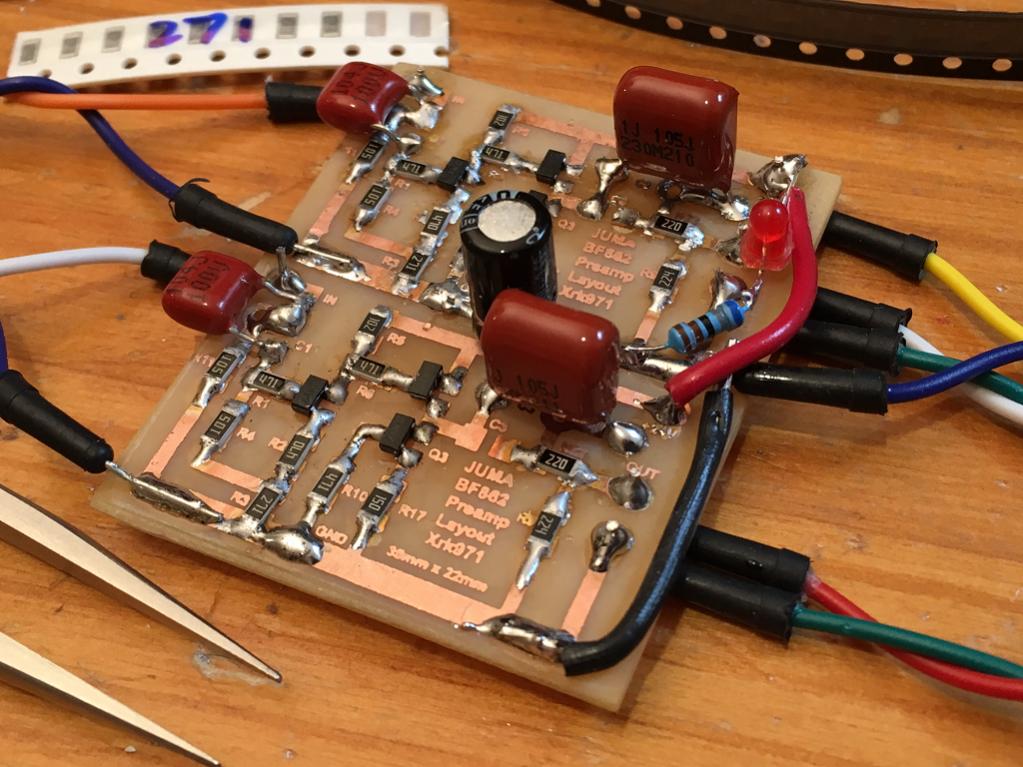
Schematic - replace R4 with 50k for lower distortion.
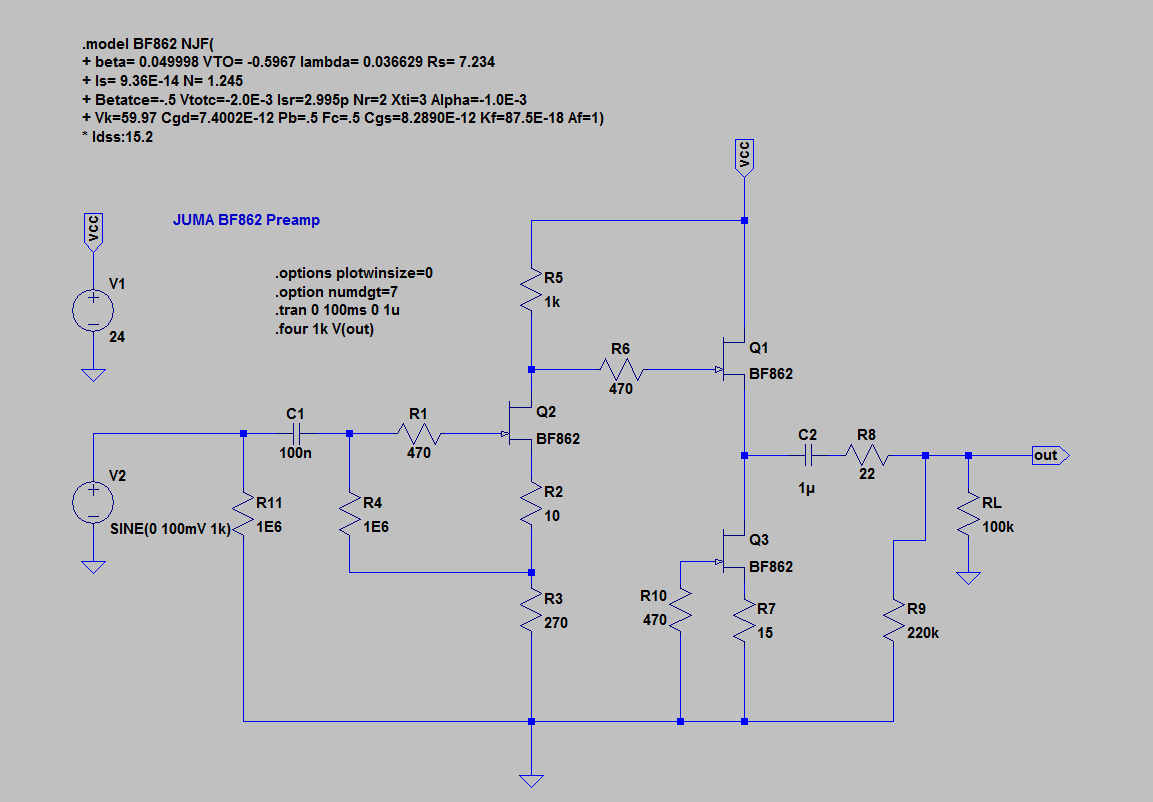
Sim of FFT in LTSpice:
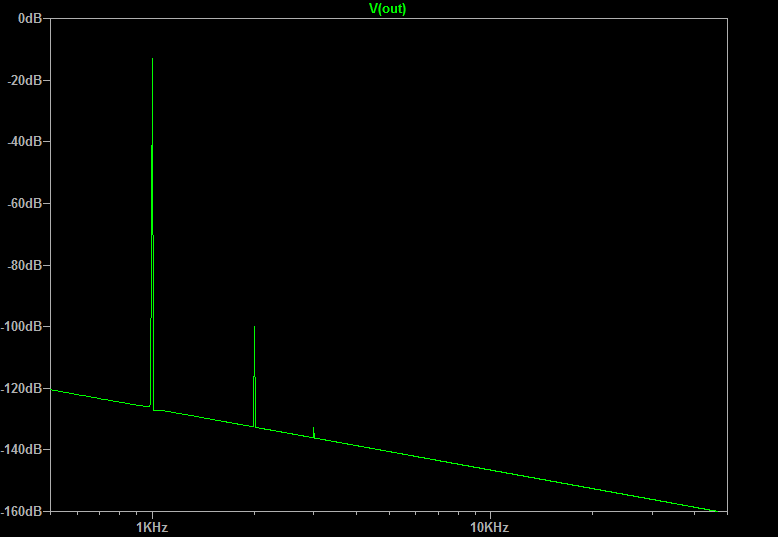

Schematic - replace R4 with 50k for lower distortion.

Sim of FFT in LTSpice:

Last edited:
I really like this circuit. It is a traditional tube topology using jfets, delicious, X!!
Thank you for bringing it to us!
HD
Thank you for bringing it to us!
HD
That preamp is a another great Juma design. Everything by Juma that I have made works well and sounds great.
After 5 hours of extended listening session with all sorts of music, I can positively say that this amp rocks. Incredible bass and dynamics. Stunning detail without being taxing. Clear smooth mids with wonderful vocal articulation. A joy to listen to. You rediscover songs and hear things you missed with other amps/headphones. My DT880-250's are a perfect match for this amp. The bias is rock-stable and the DC offset is very steady as well (about 20mV on one side 8mV on the other). In short, no other headphone amp has dynamics and bass authority like this one. I love the absolute silence and blackest blacks when music is not playing or there are quiet passages.
Hope everyone has great Xmas and new year. Happy holidays folks.
Hope everyone has great Xmas and new year. Happy holidays folks.
X,
I'm really not surprised...... the SE topology and the wonderful harmonic profile almost guarantees good sound.
I see these BF862 from NXP are rated at 20V, and at 24V Vcc is might be pushing it.... can you reduce it to 18V and keep the wonderful sound quality?
I notice you use a 1M biasing the gate of the input device. Since this is a bootstrapped input stage you could reduce the 1M to 220K keeping in Zin very high whilst picking up on resolution. This is an old tube trick; this is a SS analog after all.
Of course, more resolution might fatigue, don't know, but an easy change to see if it makes any difference to the sound.
Ciao,
Hugh
I'm really not surprised...... the SE topology and the wonderful harmonic profile almost guarantees good sound.
I see these BF862 from NXP are rated at 20V, and at 24V Vcc is might be pushing it.... can you reduce it to 18V and keep the wonderful sound quality?
I notice you use a 1M biasing the gate of the input device. Since this is a bootstrapped input stage you could reduce the 1M to 220K keeping in Zin very high whilst picking up on resolution. This is an old tube trick; this is a SS analog after all.
Of course, more resolution might fatigue, don't know, but an easy change to see if it makes any difference to the sound.
Ciao,
Hugh
X,
I'm really not surprised...... the SE topology and the wonderful harmonic profile almost guarantees good sound.
I see these BF862 from NXP are rated at 20V, and at 24V Vcc is might be pushing it.... can you reduce it to 18V and keep the wonderful sound quality?
I notice you use a 1M biasing the gate of the input device. Since this is a bootstrapped input stage you could reduce the 1M to 220K keeping in Zin very high whilst picking up on resolution. This is an old tube trick; this is a SS analog after all.
Of course, more resolution might fatigue, don't know, but an easy change to see if it makes any difference to the sound.
Ciao,
Hugh
Thanks for the tips Hugh. I just double checked and supply is actually 20v after cap Mx. Without the class A load the voltage was 24v. So it seems to sound fine at 20v anyhow. I will reduce that input resistor to 220k and see if it makes a difference. I am looking for a suitable case to put this in. Not too many of my amps make it past plywood board stage. So you know it must be good.
That preamp is insanely simple and just surprises the heck out of me how good 3 FETs can sound and provide gain. We are talking about "AM radio" gain stages as they are called by the manufacturer. BF862's are dirt cheap - one of the best bargains in all of DIY audio.
... you could just 'tack-on' a 220kR across the 1MR - a standard resistor with short leads
Are we talking about changing R4 or R11? (I assume R4?):

(Hugh, what does bootstrapped input gate mean in this case? Usually I thought that meant that there is bias provided by a cap fed from a rail? Or is R4 the bootstrap and R11 the input gate impedance setting resistor?) in the sims it showed reducing R4 to 50k reduces distortion.
Last edited:
X,
R4, the bias resistor which generates the operating point for Q2. Sorry I was not clear.
If you decrease R4 you might increase C1 to 220nF. Aside from that, no changes.
This bias generator, sometimes called 'self-bias' with tubes, carries the bias voltage from the two resistors (10R/270R) to the gate, but the operating point moves up and down and so does the gate voltage with it, so the impedance of R4 is magnified by this bootstrap action. Self talks about bootstrapping on input stages to SS as well; worth a look.
I have been following Juma's work for decades, from back when he lived in Zemun. There are lots of very clever people from this part of the world; Dadod is another. Juma's transposition of tube ideas to jfet is up there with NP in my view.
I do this trick on self-biased cathode followers, and the improvement in resolution is astonishing.
Hugh
R4, the bias resistor which generates the operating point for Q2. Sorry I was not clear.
If you decrease R4 you might increase C1 to 220nF. Aside from that, no changes.
This bias generator, sometimes called 'self-bias' with tubes, carries the bias voltage from the two resistors (10R/270R) to the gate, but the operating point moves up and down and so does the gate voltage with it, so the impedance of R4 is magnified by this bootstrap action. Self talks about bootstrapping on input stages to SS as well; worth a look.
I have been following Juma's work for decades, from back when he lived in Zemun. There are lots of very clever people from this part of the world; Dadod is another. Juma's transposition of tube ideas to jfet is up there with NP in my view.
I do this trick on self-biased cathode followers, and the improvement in resolution is astonishing.
Hugh
Last edited:
Thanks for the explanation Hugh. I am about to give this a try. Will lowering R4 change the voltage gain of this preamp? I need the gain in order to drive the unity gain follower power amp.
No, X, it will not change the gain at all.....
Really interested in the results. I have a feeling it will improve the resolution, not that it needs it! Making something wonderful spooky supernatural, huh?
Hugh
Really interested in the results. I have a feeling it will improve the resolution, not that it needs it! Making something wonderful spooky supernatural, huh?
Hugh
- Home
- Amplifiers
- Headphone Systems
- MOSFET Source Follower Headamp
